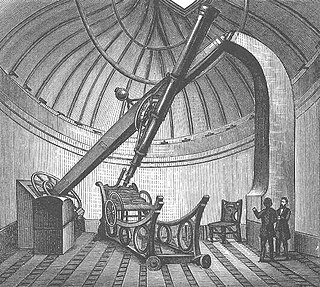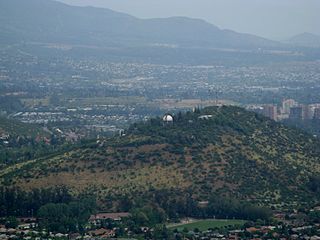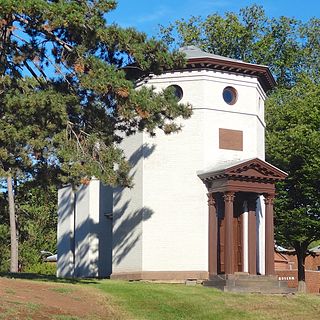 W
WThe Altona Observatory was an astronomical observatory situated in the Palmaille, in Altona, Hamburg. The observatory was founded by Heinrich Christian Schumacher in 1823 and continued to operate until 1871, 21 years after his death. It closed due to funding being cut off following the cession of the 'Elbe Duchies' of Schleswig, Holstein, and Saxe-Lauenburg by Denmark to Austria and Prussia following the Second Schleswig War.
 W
WBarnard Observatory was a U.S. astronomical observatory owned and operated by University of Mississippi in Oxford, Mississippi. Completed in 1859, it was part of the astronomy focus that chancellor Frederick A.P. Barnard had for the school. Due to the outbreak of the Civil War, though, the purchase of the observatory's telescopes were put on hold. Today the observatory houses the Center for the Study of Southern Culture while the university's astronomers use Kennon Observatory.
 W
WBiały Słoń is a Polish name for an abandoned campus of the former Polish Astronomical and Meteorological Observatory of Warsaw University, located at remote area on the peak of Pip Ivan in the Chornohora range of the Carpathian Mountains, Ukraine. Currently the structure is used as a mountain shelter with a small search and rescue team with some rooms adopted for lodging and recovery.
 W
WThe Black Moshannon Observatory (BMO) was an astronomical observatory owned and operated by Pennsylvania State University. Established in 1972, it was located in the central part of the U.S. state of Pennsylvania in Black Moshannon State Park, approximately 17 kilometers (11 mi) northwest of State College. The observatory was closed some time after August 1995.
 W
WBlue Mesa Observatory (BMO), also referred to Magdalena Peak Station for the International Planetary Patrol Program, was an astronomical observatory owned and operated by New Mexico State University (NMSU). It was located on Magdalena Peak in the Sierra de las Uvas of southern New Mexico (US), approximately 43 kilometers (27 mi) northwest of Las Cruces. Founded in 1967 under the supervision of Clyde Tombaugh, the observatory was closed in 1993. The site and the 30 acres surrounding it were conveyed to the Federal Aviation Administration, which tore down the observatory building and replaced it with a radar installation.
 W
WCloudcroft Observatory, is an astronomical observatory located in the Lincoln National Forest near Cloudcroft, New Mexico, approximately 23 kilometers (14 mi) northeast of Alamogordo. It is owned by the Tzec Maun Foundation, a private astronomical organization.
 W
WCorralitos Observatory was an astronomical observatory located in the Rough and Ready Hills approximately 30 kilometers (19 mi) west of Las Cruces, New Mexico. It was formally dedicated on October 12, 1965, serving as a remote station of Dearborn Observatory, Northwestern University. In October 1965, a NASA program to detect transient lunar phenomenon (TLP) was begun by the staff. Using two-person observer teams, a total of 6,466 man-hours of lunar observation was recorded. The program was run until 1972 but did not confirm any TLP. Using ninety-eight selected reports of TLPs received from amateurs during this period, 39 were checked from Corralitos Observatory.
 W
WCreighton University Observatory is located on the Creighton University campus in Omaha, Nebraska, United States. It was the first observatory in Omaha, and the second in Nebraska. It was used primarily for the instruction of students, though the directors did do some research in the observatory. It still stands today on the campus grounds, though there is currently no public access.
 W
WDaniel Scholl Observatory was the astronomical observatory built by Franklin and Marshall College in Lancaster, Pennsylvania. Construction began in 1884 and the building was dedicated June 16, 1886. Total cost of the observatory and equipment was $13,579.Building cost- $3,000 Steel Dome $2,000 by Grubb & Sons, Dublin, Ireland Equipment cost-$8,579 total $4,199 for 11" Repsold Telescope $2,200 lens manufactured by Alvan Clark & Sons, Cambridge, Massachusetts $2,180 for chronometer, chronograph, transit, clock and other equipment
 W
WDarling's Observatory was a private observatory built by Mr. J. H. Darling in Duluth, Minnesota, United States. The site of the observatory was on West 3rd St. between 9th and 10th avenues in Duluth, MN, and sat about 325 feet above Lake Superior. Plans for the building were drawn by Richard E. Schmidt of Garden & Martin of Chicago. The blueprints for the steel dome were prepared by Mr. Darling himself after inspecting domes from various other observatories. The wooden building had a stucco exterior finish.
 W
WGeorge Bishop's Observatory was an astronomical observatory erected in 1836 by the astronomer George Bishop near his residence at the South Villa of Regent's Park, London. It was equipped with a 7-inch (180 mm) Dollond refractor.
 W
WGyarah Sidi are the remains of the astrological observatory of the Mughal Emperor Humayun. The ruins are situated at a stone’s throw from Babur’s Mehtab Bagh, in a field on the banks of the Yamuna river in Agra.
 W
WIsaac Roberts' Observatory was an observatory, installed in the private home of the British astronomer Isaac Roberts. It was in Crowborough, Sussex, and was active from 1890, when Roberts installed it, until his death in 1904. The observatory appears in the List of observatory codes of the Minor Planet Center with the code 001.
 W
WThe Kenwood Astrophysical Observatory was the personal observatory of George Ellery Hale, constructed by his father, William E. Hale, in 1890 at the family home in the Kenwood section of Chicago. It was here that the spectroheliograph, which Hale had invented while attending MIT, was first put to practical use; and it was here that Hale established the Astrophysical Journal. Kenwood's principal instrument was a twelve-inch refractor, which was used in conjunction with a Rowland grating as part of the spectroheliograph. Hale hired Ferdinand Ellerman as an assistant; years later, the two would work together again at the Mount Wilson Observatory.
 W
WThe King's Observatory is a Grade I listed building in Richmond, London. Now a private dwelling, it formerly housed an astronomical and terrestrial magnetic observatory founded by King George III. The architect was Sir William Chambers; his design of the King's Observatory influenced the architecture of two Irish observatories – Armagh Observatory and Dunsink Observatory near Dublin.
 W
WKoenigsberg Observatory was an astronomical observatory and research facility which was attached to the Albertina University in Königsberg, what is now Kaliningrad, Russia. The observatory was destroyed by Royal Air Force bombs in August 1944 during the Second World War.
 W
WThe Lamont–Hussey Observatory (LHO) was an astronomical observatory owned and operated by the University of Michigan (UM). It was located in the city of Bloemfontein, Free State, South Africa. Construction at the site began in 1927, and the facility was closed in 1972.
 W
WLindheimer Astrophysical Research Center was an astronomical observatory used for teaching and research, located on the Evanston, Illinois campus of Northwestern University. The structure was built in 1966 and was demolished in 1995.
 W
WThe National Astronomical Observatory of Chile is an astronomical observatory owned and operated by the Department of Astronomy of the University of Chile (UCh). It is located on Cerro Calán, a hill in the commune of Las Condes. The commune is an eastern suburb of Santiago located in Santiago Province of the Santiago Metropolitan Region. OAN was founded in 1852 and became a part of UCh in 1927. The facility on Cerro Calán was completed in 1962.
 W
WMarkree Observatory was an astronomical observatory in County Sligo, Ireland. The asteroid 9 Metis was discovered from this observatory in 1848 by Cooper's assistant Andrew Graham using a comet seeker telecope. The observatory was also home to the largest refractor of the early 1830s, which had a 13.3-inch (340 mm) aperture Cauchoix of Paris lens; the largest in the world at that time. The observatory also housed a number of instruments and was operated to varying degrees throughout the 19th century.
 W
WNASA Orbital Debris Observatory (NODO) was an astronomical observatory located in the Lincoln National Forest near Cloudcroft, New Mexico approximately 23 kilometers (14 mi) northeast of Alamogordo. From 1995 to 2002 it hosted two telescopes funded and operated by NASA that were dedicated to detecting orbital debris. The facility was initially called the Cloudcroft Electro-Optical Research Facility when it was completed in 1962, and was also known as the Cloudcroft Observatory. It is now privately owned.
 W
WThe Portage Lake Observatory (PLO) was an astronomical observatory owned and operated by the University of Michigan (UM). It was located near the village of Dexter, Michigan (USA), about 20 kilometers (12 mi) northwest of Ann Arbor. Construction at the site began in 1948, and the facility was closed in 1975.
 W
WRadcliffe Observatory was the astronomical observatory of the University of Oxford from 1773 until 1934, when the Radcliffe Trustees sold it and built a new observatory in Pretoria, South Africa. It is a Grade I listed building. Today, the observatory forms a part of Green Templeton College of the University of Oxford.
 W
WRattlesnake Mountain is a 3,531 ft windswept treeless sub-alpine ridge overlooking the Hanford nuclear site. Parts of the western slope are privately owned ranchland, while the eastern slope is under the federal protection of the Arid Lands Ecology Reserve, a unit of the Hanford Reach National Monument, managed by the United States Fish and Wildlife Service. The mountain is the second highest point in Benton County, with its neighbor Lookout Summit surpassing it by only 98 ft.
 W
WThe Robotic Lunar Observatory (ROLO) was an astronomical observatory funded by NASA and located at the United States Geological Survey Flagstaff Science Campus atop McMillan Mesa in Flagstaff, Arizona. Its purpose was to enable the Moon to be used as a radiance calibration source for Earth-orbiting remote-sensing spacecraft. The program ceased observations in September 2003, but the facility is maintained for calibration and instrument characterization purposes. It consists of two 20 cm (7.9 in) Ritchey-Chrétien telescopes attached to an equatorial mount made by DFM Engineering. One telescope is fitted with a sensor optimized for visible and near-infrared (VNIR) wavelengths, while the other is tuned to short-wavelength infrared (SWIR). The VNIR camera began operations in 1995 and the SWIR camera in 1997.
 W
WThe Daniel S. Schanck Observatory is an historical astronomical observatory on the Queens Campus of Rutgers University in New Brunswick, New Jersey, United States, and is tied for the seventh oldest observatory in the US alongside the Vassar College Observatory. It is located on George Street near the corner with Hamilton Street, opposite the parking lot adjacent to Kirkpatrick Chapel, and to the northeast of Old Queens and Geology Hall.
 W
WTara Wali Kothi was an observatory commissioned in 1832 by King of Oudh Nasir-ud-Din Haidar Shah. It was not functional until 1841 when Colonel Richard Wilcox, a Royal Astronomer, was appointed.
 W
WThe Tower of the Winds is the prominent octagonal tower on top of the old Radcliffe Observatory building in Oxford, England. The building now forms a centrepiece for Green Templeton College, one of the colleges of Oxford University.
 W
WUnion Observatory also known as Johannesburg Observatory (078) is a defunct astronomical observatory in Johannesburg, South Africa that was operated between 1903 and 1971. It is located on Observatory Ridge, the city's highest point at 1,808 metres altitude in the suburb Observatory.
 W
WVartiovuori observatory is the former observatory of the Royal Academy of Turku. The building was completed 1819, and was designed by the German architect Carl Ludvig Engel. The neoclassical observatory is a typical Engel work, with obvious similarities to the Helsinki University Observatory and Pulkovo Observatory, which he also designed. The observatory is located atop of the Vartiovuori hill in Turku, close to the cathedral and Aura river and it's visible from many places in the city center.